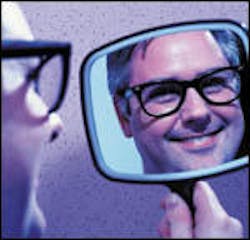The Most Beautiful Smile is ...Cancer-free!
by Kristine A. Hodsdon, RDH, BS
Aesthetic hygiene must include early detection, diagnosis, and eradication of early-stage lesions.
How aesthetically pleasing is a person who has lost his mandible to oral cancer? Or how would disfiguring facial scars from multiple surgeries in an attempt to remove an entire cancerous lesion affect your self-esteem? A family friend was diagnosed with oral cancer two years ago. Jeff, then 34 years old, had a lesion on his palate that was not healing. His first trip was to his physician's office. They prescribed antibiotic therapy, but the sore still did not go away.
His second trip was to his dental office. It was then that the lesion was diagnosed; his life and that of his family changed forever. After numerous surgeries, rounds of chemo, radiation therapy, and then a staph infection, this father of two has lost three-quarters of the inside of his mouth. His family has endured devastating challenges, and his children have had to face one of life's realities at unthinkable early ages. Will he be a survivor? I do not know, but I recognize that many clinicians probably can insert another name in the place of Jeff's.
Most of us have similar stories that we can share. But swapping tales, without taking action, will not help ensure that this does not happen to another one of our clients. Our oral health mission must include performing routine and complete oral cancer examinations on everyone!
In June, at the opening ceremonies for the American Dental Hygienists' Association, I was delighted to hear that the keynote speaker's message was, "Smokeless does not mean harmless." Joe Garagiola, the national chairman of Oral Health America (OHA) National Spit Tobacco Education Program (NSTEP), ignited emotions with real-life stories about survivors and nonsurvivors of oral cancer. He pleaded with the audience to help him spread the word about the dangers of all tobacco products and the importance of early detection. The sobering news included:
- Oropharynx cancers account for 30,000 new cases and approximately 9,000 deaths in the United States each year.
- Oral cancer kills more people nationwide each year than either melanoma or cervical cancer.
- Regular examinations of the entire mouth are essential in the early detection of both cancerous and precancerous conditions.
- Late-stage treatment usually involves major facial surgery with only half of such clients surviving after five years.
The beginning aspect of the oral cancer examination should include "tobacco use" assessment questions. Discovering tobacco use — what types (cigarettes, chew, snuff, cigars, etc.), how long, how often, and if they have tried to stop — will give you additional information to help determine the risk level of the client and the willingness to begin or not begin a cessation program. The clinical skills needed for basic extraoral and intraoral assessment include: observation (viewing or watching), palpation (touch), auscultation (listening to body sounds), and olfaction (sensing body odors). In addition, schedule and take appropriate preventive full-mouth radiographs and panoramic films.
Communicate to your clients that you will be performing an oral cancer examination and why. Discuss with them the importance of yearly cancer examinations, warning signs of oral cancer, and the hazards associated with tobacco and alcohol use. Let them know that, if a sore or a lesion appears in or around the mouth/lips, call the "mouth doctor" first!
Hygienists are not alone in the charge to promote oral health and fight oral cancer. The Crown Council [(800)-276-9658], which is a national organization of dental practitioners committed to promoting good oral health, participated in the "Save a Smile/Save a Life" campaign. The Crown Council, OHA, NSTEP, the Mayo Clinic, Romano & Associates, Inc., and minor league baseball formed a coalition. Each participant had a role in creating, funding, organizing, and delivering the services necessary to make the campaign successful during its run from April 1 to July 30.
The campaign established a toll-free number, developed and distributed public service announcements, and gave local Crown Council practices an opportunity to develop an oral health awareness program with a local minor league baseball team. The minor leagues have had a tobacco-free policy in place since 1993.
In addition, Sullivan-Schein Dental provided free of charge Oral CDx Kits (www.oralcdx.com) to Crown Council offices that performed brush biopsies in conjunction with oral cancer examinations. During the campaign, each participating office encouraged every client who came into the office for an oral cancer examination to contribute $40 to the Save a Smile/Save a Life (SAVE) Foundation. Equally, all clients who required a biopsy that used the Oral CDx instrument were asked to contribute the cost of the biopsy to the SAVE foundation. The best part is that 100 percent of the funds collected will be used to further the cause of oral cancer awareness. So for all those who participated, thank you!
For readers who are not familiar with the Oral CDx brush biopsy, it is a chairside transepithelial oral biopsy. This is important because cellular abnormalities from precancer and cancer sometimes can be observed only in the deepest layer.
This test is valuable because one of the dangers with the visual screening of oral cancer is the difficulty in clinically differentiating premalignant and malignant lesions from similar-looking benign lesions. Many times, early-stage oral cancers are asymptomatic and overlooked by clinicians. Chairside tests such as the computer-assisted brush biopsy can easily make the distinction between such lesions (check individual state practice acts to determine if this is a hygiene function).
Aesthetic hygiene must include early detection, diagnosis, and eradication of early-stage lesions. In addition, public education should stress the importance of annual cancer examinations, identification of the warning signs, and recognition of the hazards associated with tobacco and alcohol use.
Collectively, these steps make up the most effective system for battling oral cancer. Let's make a commitment — no more family members, clients, or strangers will go through what Jeff and his family are enduring.

